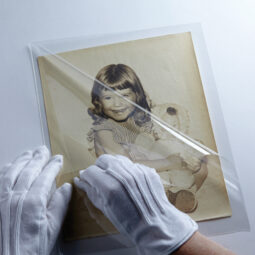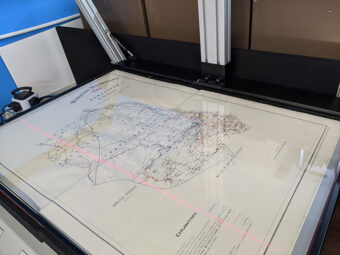
Unlike Wine, Tape Does Not Improve With Age
Tapes do not improve with age. Quite the opposite. Corporates, consumer and heritage clients have vast archives of magnetic tape that contain information that needs to be preserved. 70% of all audio-visual material is under the threat of deterioration, damage or obsolescence. From about 1950 through the 1990s, most of the world’s audio-visual was entrusted […]
Tapes do not improve with age. Quite the opposite. Corporates, consumer and heritage clients have vast archives of magnetic tape that contain information that needs to be preserved. 70% of all audio-visual material is under the threat of deterioration, damage or obsolescence.
From about 1950 through the 1990s, most of the world’s audio-visual was entrusted to analogue magnetic recording tape for archival storage. Now that analogue magnetic tape has moved into a niche archival market, that we at Oxford Duplication Centre specialise in, it is time to reflect and realise that it is time to start worrying about the remaining lifetime of existing tapes.
Video tapes are fundamentally composed of three layers:
1. the binder layer – magnetic particles responsible for signal quality
2. the substrate – stability, strength and friction support
3. the backing – stability, strength and friction support
Corporate and consumer tapes all share one thing in common: they are magnetic media. There are many ways tape can deteriorate:
• Magnetic particles gradually lose their charge, in a process called remanence decay resulting in some colour shift toward weaker hues and loss of detail.
• Magnetic particles may accidentally demagnetise. This can be from storing too near a magnetic source or even from the playback machine itself.
• The lubricant in the binder layer is used up. With each playback it erodes, the binder layer itself takes on more wear, which can directly cause information loss.
• The binder layer can become a sticky and unplayable. The binder’s polymers will absorb water eventually delaminate. Typically called sticky-shed syndrome. Playing a tape in this condition will damage both tape and the playback machine.
• The backing and substrate can become stretched. Multiple rewinding’s and playback. This causes tracking errors that can dramatically reduce playback quality.
Conclusion
If the content is important and should not be lost, copy it now. Do not rely on old tape. Unlike wine, tape does not improve with age. Developing a logical plan and sticking with it is an important part of preserving the audio-visual assets in your collection. It is important to consider that equipment and related knowledge about how to play older tapes will not survive much longer. Fortunately, at Oxford Duplication Centre we hold some of the rarest tape machines which are serviced and maintained by our experienced team.
Kind regards
Cheryl
Director
Oxford Duplication Centre
Corporate, Consumer and Heritage Digitisation
29 Banbury Road
Kidlington
Oxfordshire OX5 1AQ
Tel: 01865 457000
Current opening hours: Monday to Friday 10-3pm by appointment only
cheryl@oxfordduplicationcentre.com
www.oxfordduplicationcentre.com
More in Business Services

Reliable Vehicle Servicing and Repairs with Pete Thirtle
When it comes to maintaining and repairing your vehicle, trust and expertise are paramount. That’s why Pete Thirtle Vehicle Services stands out as one of the go-to independent garage for drivers in Bicester, Oxford, and the surrounding areas. With a reputation built on honesty, reliability, and top-tier service, Pete can ensure that your vehicle receives the best care possible. B4’s CEO, Richard Rosser, shines the spotlight on the ultra-reliable, Pete Thirtle.

Catering laundry solutions for spotless table linens by Freya Gutteridge, Oxwash
In the catering industry, pristine table linens are essential for enhancing both presentation and hygiene. Crisp, spotless linens create a professional atmosphere and ensure a safe dining environment for guests. Effective laundry solutions, such as the use of biodegradable detergents and advanced washing techniques, help maintain fabric quality and remove tough stains without harming the environment.

Intertronics: Driving Innovation in Adhesives and Assembly Solutions
For over four decades, Intertronics has been at the forefront of providing high-performance adhesives, coatings, sealants, and application equipment to industries that demand precision and reliability. From electronics and medical devices to automotive and aerospace, Intertronics’ expertise ensures that manufacturers can optimise their bonding and assembly processes with cutting-edge solutions.
From this author

Do You Have Paperbased Records – Its Time to Protect Those...
A very important reason to archive your documents and archives is to avoid losing data. All documents are vulnerable to being destroyed, deleted, natural disaster, such as a flood or fire. A more serious reason for document archiving is deterioration of the papertypes. I cannot count the number of times we have experienced paper […]

Maps, Plans & Posters | Oversized Scanning Solutions
Our services at Oxford Duplication Centre offer oversize scanning solutions for maps, plans and posters of any document type, from parchment, linen, cotton and paper. Our archive technicians have extensive experience in digitising complex document types into high quality digital files, ideal for archival purposes, viewing and uploading. Output formats are straightforward offering any type […]

Why You Should Consider Your Documents And Have Them Digitally Preserved.
Digitising paper documents into secure & accessible electronic records. Our services at Oxford Duplication Centre offer a complete range of document scanning solutions to digitise archives of existing records. We can handle any type of document, from student records to complex technical drawings, from a single file through to entire archives. Our services digitise upto […]


